Your cart is currently empty!
Blog
Malla period: The Golden Age of Sculpture and Art
Nepalese traditional arts and architectures are totally dominant in Hindu and Buddhist religious philosophies which are reflected by various kinds of painting images, statue sculptures of deities, temples, monasteries, old squares, and other monuments. While many inventions have made artmaking easier and available to all, others have conducted in radical concepts and new understandings of how we define “art.”
Especially Kathmandu valley’s squares, monasteries, surrounding areas’ various pilgrimage places, Lumbini, Janakpur and, world heritage spots are main evidence of Nepalese traditional arts and architectures. In Kathmandu valley, both neighboring ancient cities Patan and Bhaktapur are well renowned due to its wonderful tradition in subjects of Nepalese traditional arts and architecture ever outstanding.
Some artistic innovations from centuries ago are now so deeply ingrained in the modern consciousness, it’s hard to imagine what art would be without them. It is undoubtful that Nepal is rich in art, culture, traditional values, warm hospitality, and very own distinct history.
During the Malla period, which spanned more than five hundred years (1200-1769), trade, agriculture, religion, and culture flourished in the Kathmandu Valley, fostering tremendous growth in the production of sacred art. Below we share the brief history of Malla art that, whether historically, practically, or conceptually, have changed artmaking for good.
1. Krishna Temple
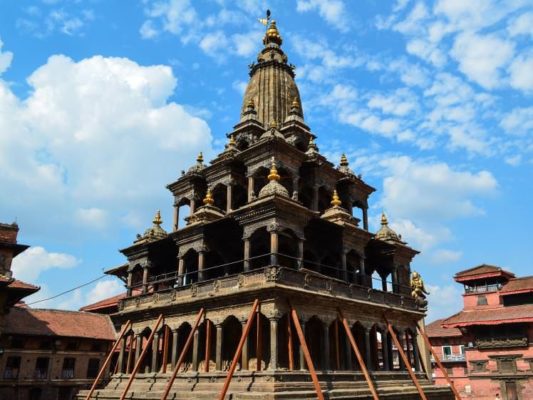
The octagonal Krishna Temple was built in 1648-49 by Pratap Malla, either as a response to rival Siddhinarshingh Malla’s Krishna Temple in Patan or as a religious consolation for his earlier failure to conquer that city, or in memory of his two wives, or a combination of all three. The three-tiered traditional Newari building is supported by stone columns around the circumference of the base. The image of Krishna inside the temple is accompanied by his two wives, Satyabhama and Rukmani, all of which, according to a Sanskrit inscription, bears a deliberate resemblance to Pratap Malla and his own two queens. Inside are the images of Krishna and two goddesses, which, according to a Sanskrit inscription, are modeled on the king and his two wives.
2. Stone inscription
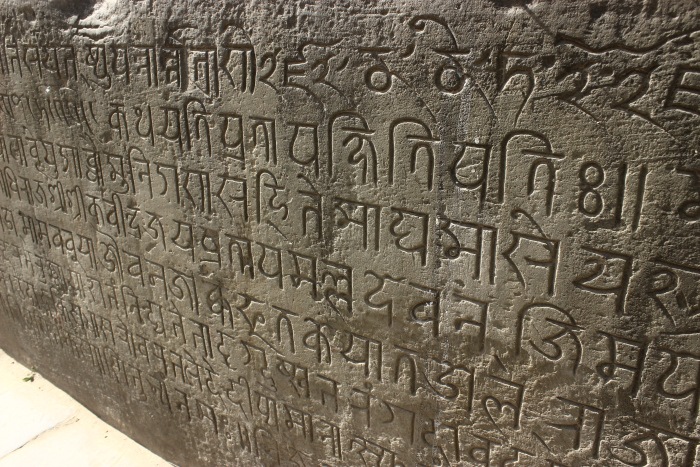
Pratap Malla’s stone inscription in Kathmandu Durbar Square which he set up on 14 January 1664. We can clearly discern the English word in WINTER.
On the outside of the white wall of Kathmandu Durbar, opposite the Vishnu Temple, is a long low stone inscription to the goddess Kalika written in fifteen different languages, including European languages. Pratap Malla, renowned for his linguistic abilities, set up this inscription on 14 January 1664. A legend tells that milk will flow from the spout in the middle if somebody is able to decipher all fifteen languages.3. Kal Bhairav Statue
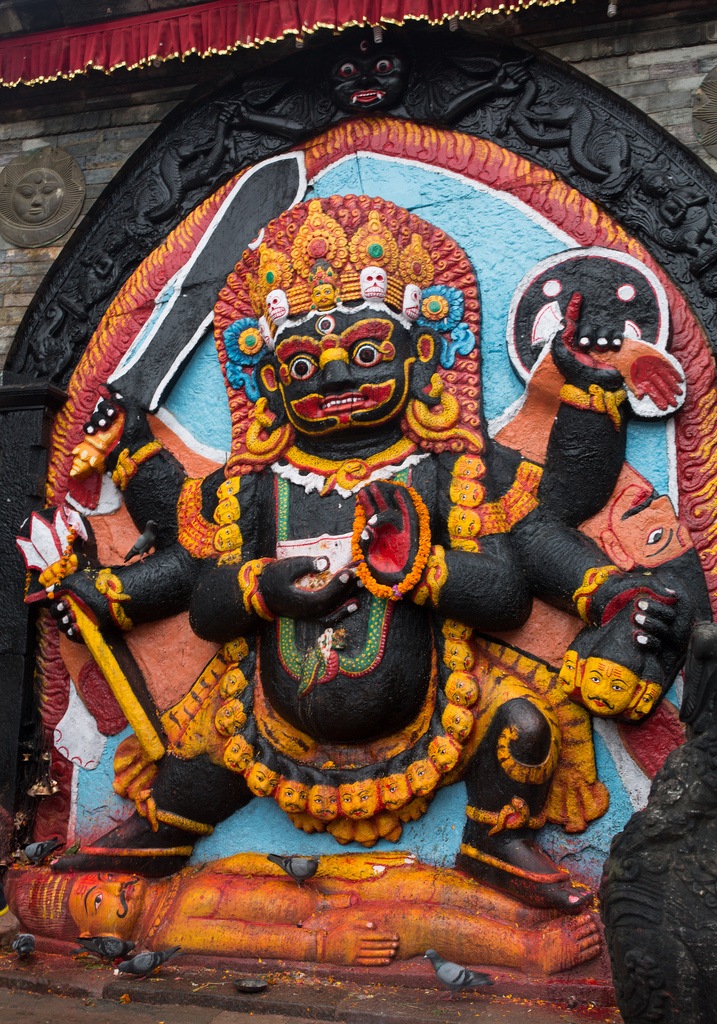
Kalbhairav Statue, Shiva in his destructive manifestation, at Hanuman Dhoka Dharwar Square North of the Jagannath Temple is the figure of Kala Bhairab. Bhairab is Shiva in his most fearsome aspect, and this huge stone image of the terrifying Kala Bhairab has six arms, wears a garland of skulls, and tramples on a corpse, which is symbolic of human ignorance. The figure is said to have been brought to its present location by Pratap Malla, having been found in a field to the north of the city. The image was originally cut from a single stone but the upper left-hand corner has since been repaired. It is said that telling a lie while standing before Kala Bhairab will bring instant death and it was once used as a form of trial by ordeal.
4. Pratap Malla’s Column
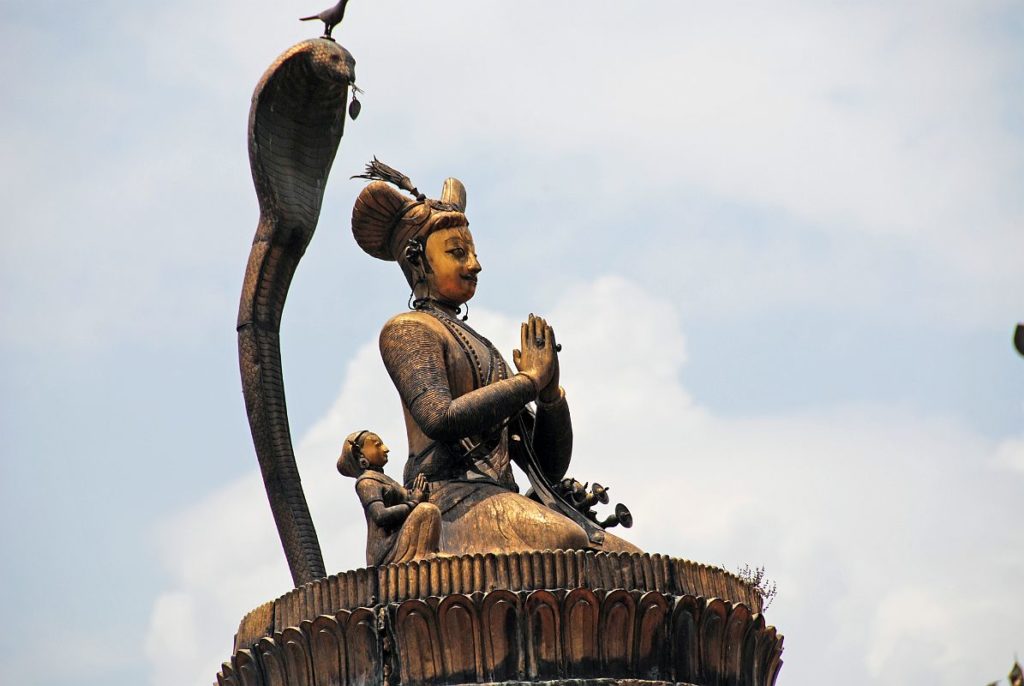
Statue of Pratap Malla with his wives and sons at Hanuman Dhoka Palace.
Across from the Krishna Temple, standing on a slightly raised platform in front of the Hanuman Dhoka is the square stone pillar, known as the Pratap Dhvaja. It is topped by a statue of King Pratap Malla, seated with folded hands and surrounded by his two wives and his five (including an infant) sons. He looks towards his private prayer room on the third floor of the Degutaleju Temple. The column was erected in 1670 by Pratap Malla and preceded the similar columns in Patan and Bhaktapur.5. Taleju Bhawani
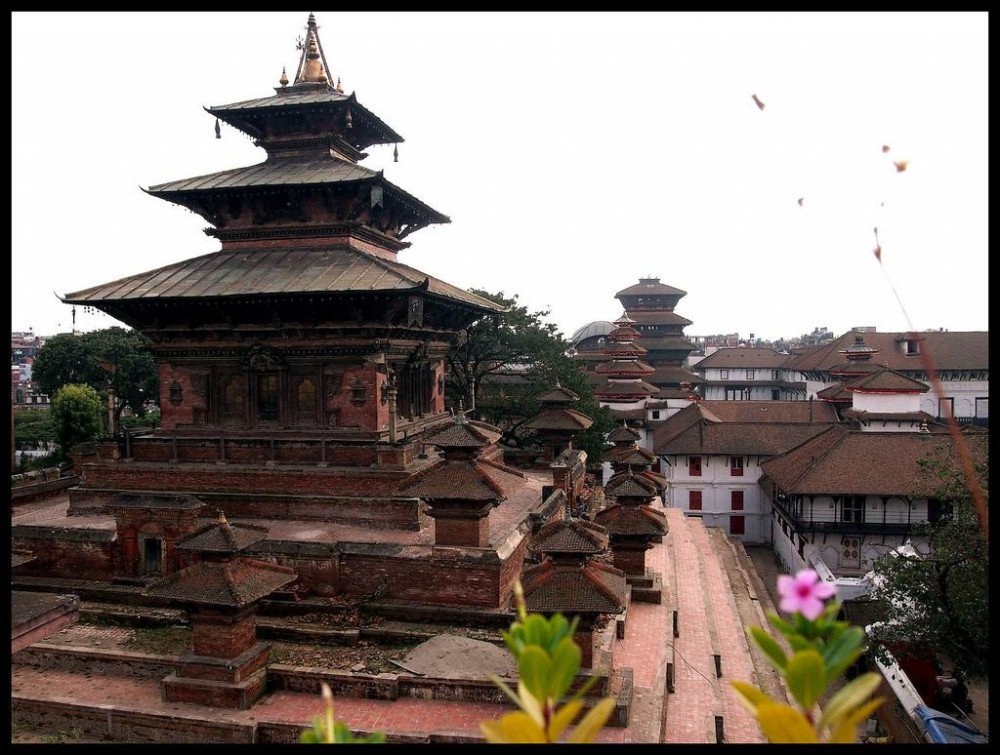
Taleju became the guardian deity of the Malla kings and Taleju temples were built in her honor in all three cities. The temple is one-storeyed. The artworks found in the temple are regarded among best in Nepal. The temple square consists of two shrines for two female deities, Taleju Bhawani and Kumari. The temple of Taleju has always been one of Bhaktapur’s most sacred spots, traditionally closed to all but the reigning kings. The Taleju temple stands in the Mulchok Court. At present, only Hindus are allowed to go inside the temple and the goddess cannot be photographed.
6. Kumari Ghar
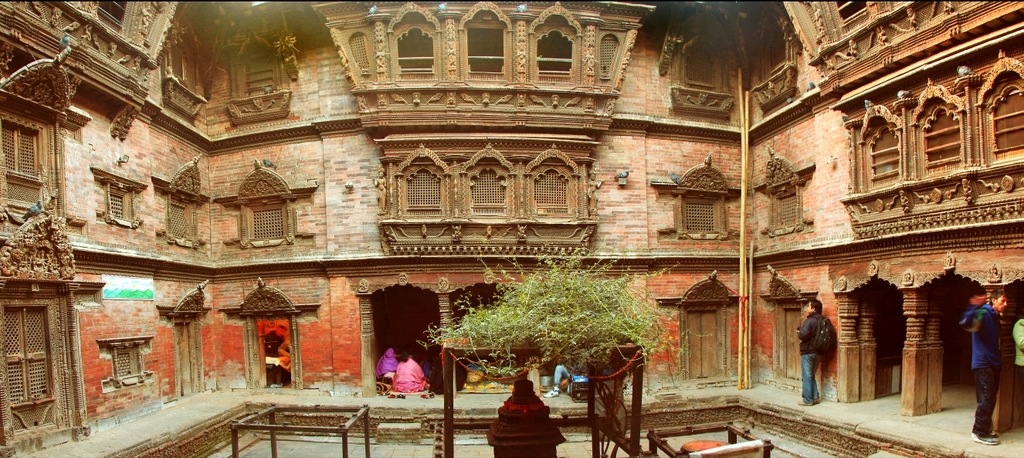
Just beside the Kathmandu Durbar Square, there stands big 3 storied Kumari Ghar which is home for the kumaris “The Living Goddess of Nepal”. It is, therefore, the holy monument for all the Nepalese that exemplify ornate craftsmanship. Typically, it is popular for extra-ordinary carved wooden balconies and windows comprising a gold crafted window as well which was built by King Jaya Prakash Malla in 1727 A.D.
Tourist may enter through the courtyard and are allowed to take pictures where they will find the immense masterful traditional carving of gods and the symbols over doors, pillars, and windows but they are strictly prohibited to take pictures of kumari who sometimes appear at any of the windows of the first floor.
You may be interested in:
[product_embedder_blogs product_id=”2100″]
[product_embedder_blogs product_id=”1558″]7. Rani Pokhari
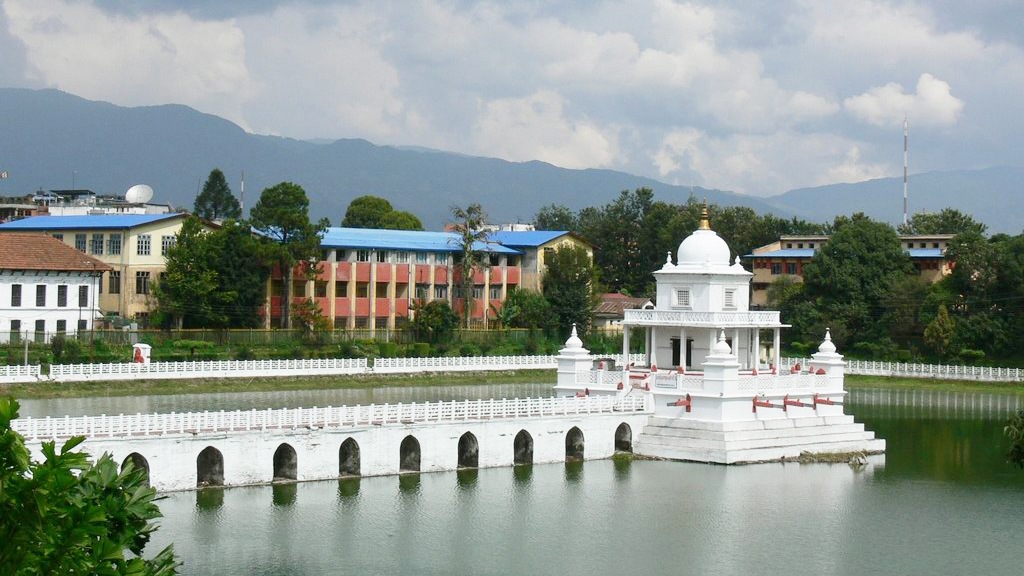
Ranipokhari lies in the heart of Kathmandu, with about fifteen minutes’ walk from Kathmandu Durbar Square. Rani Pokhari, meaning Queen’s pond, is the artificial square-shaped pond with the temple of Shiva in the middle. The Rani in question was Pratap Malla’s queen who in 1667 commissioned its construction in memory of their son, Chakravatendra Malla, who, following his father’s abdication in favor of his four sons each of whom would rule for one year, died on the second day of his reign, apparently having been trampled by an elephant.
The water with which the pond was originally filled was taken from fifty-one sacred rivers throughout Nepal and India, thus ensuring its sanctity. The temple in the middle of the pond has a domed roof reminiscent of classical Indian Mughal architecture and is surmounted by a copper spire. The main image is of the Shiva lingam, but other deities also feature. Four small shrines at each corner contain images of Bhirab, Harishankar, Shakti, and Tarkeshwari. On the southern embankment is a statue of an elephant carrying three passengers on its back, thought to be three of the male members of the Pratap Malla’s family, while a fourth person is held in its trunk.
Various myths and legends have come to be associated with Rani Pokhari over the years. It is said to be haunted by ghosts, including one especially seductive female specter who managed to unnerve even the great Pratap Malla. The pond is fenced with iron bars, apparently to prevent suicide by drowning, and opened once a year during Bhaitika, the fifth and final day of Tihar.
It has been over two years since President Bidya Devi Bhandari laid the foundation stone to mark the beginning of the Rani Pokhari’s reconstruction, on January 16, 2016, following the 2015 earthquake that had badly damaged the structure.
8. Gai Jatra
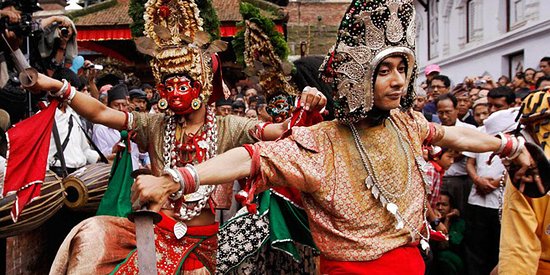
When King Pratap Malla lost his son, his wife, the queen, remained grief-stricken. The king was very sad to see the condition of his beloved queen. The king, in spite of several efforts, could not lessen the grief of his wife. He desperately wanted to see a little smile on her lips; so he announced that anyone who made the queen laugh would be rewarded adequately. During the festival of Gai Jatra, the cow procession was brought before the grief-stricken queen. Then the participants began ridiculing and mocking the important people of the society.
Finally, when the social injustices and other evils were highlighted and attacked mercilessly, the queen could not help but smile. The queen laughed and the king instituted a tradition of including jokes, satire, mockery and lampoon into the Gaijatra celebration. As per the traditions, every family who has lost a relative during that past year participates in a procession through the streets leading a cow. If a cow is unavailable, a young boy dressed as a cow is substituted.
9. Swayambhunath
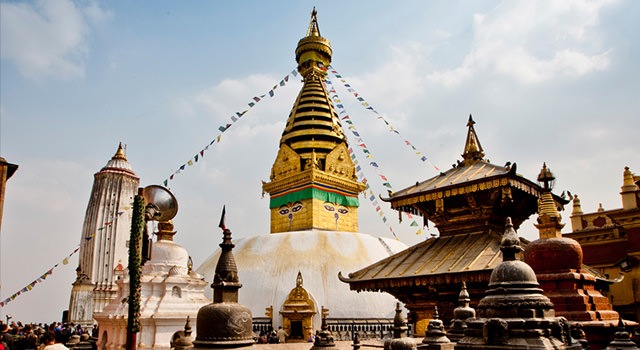
In 1614 additions and renovations of Swayambhunath complex were made by Zhamarpa VI during the reign of Pratap Malla. Access from Kathmandu was improved with the construction of a long stairway and a bridge across the Vishnumati. At the bottom of the 400 stone steps are three painted images symbolizing the Three Precious Jewels of Buddhism, which were erected in 1637 by Pratap Malla and his son, Lakshmana Singh Malla.
10. Shikara-style Shiva temple in Bhaktapur

In 1674 Jitamitra Malla built a Shikara-style Shiva temple with a gilded repousse mask of the God on each side in Bhaktapur. In 1682 he built near the Durbar the two-storied Dharmasala Palace in which there is a golden Mahadeva. The palace was used by royalty until 1769 and today is a museum and part of the World Heritage Site on Durbar Square. To the east of this, he erected the temple and statue of Narayana, along with the temples of Dattatrikasa and Pashupati.
An inscription in 1678 states that he built the royal palace Thanathu Dubar and its gardens and courtyard. Jitamitra was also credited with restoring Kumari Chowk, the images of Astamatrikas and in 1690, donated two large cooper kettledrums (nagara) or bells to his favorite deity, the goddess Taleju for the gilded roof of Taleju. He also contributed a finely carved wooden tympanum above the main entrance to the Mul Chowk and also erected many memorials in Bhaktapur.
You May Also Like To Read Arts And Crafts Of Nepal
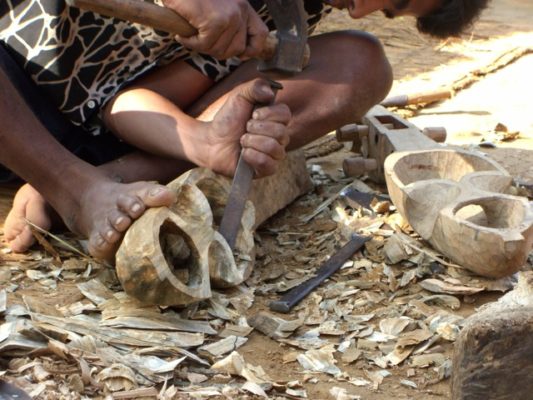
Beautifully Timeless, Iconic and Much-Loved Sarangi Players of Nepal
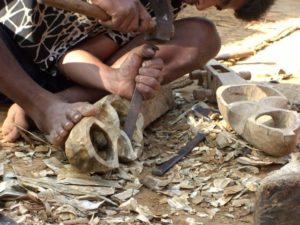
Sarangi, a traditional Nepali musical instrument is the best friend of Ghandarvas – a community of Kaski district. Their songs’ power comes from their soul instruments—the sarangi and the arbaja—and in that haunting voice they are known for, they bring forth the bhakas, the stories, the karkhas, the seasonal songs, and the festive songs.
Sarangi a four-stringed instrument played upright, with a bow is handcrafted out of a single piece of wood, hollowed at the base then covered with leather. It is played by rubbing on the wire and can be said to be a miniature version of violin owing to its technique and structure. The people of Gandharva community play this instrument along with the song they compose about real life incidents and events which they can relate with. The instrument’s sound resembles the human voice laced with rich oriental undertones.
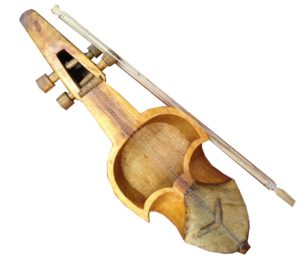
In times, prior to postal era, telephones and introduction of modern technologies the Ghandarvas traveled singing about legendary heroes, ongoing battles and incidents of what they saw on their journeys.
Today, because of digital connectivity, the time-honored storytellers Gandharvas have been losing their authenticity rapidly. Though the sarangi holds a significant role in the folk genre of Nepalese music due to globalization and commercialization of music and entertainment, the tradition is slowly dying and the instrument itself faces extinction. Despite, Gandharvas losing their identity, there are still few places in Nepal where the authentic Gandharva culture can be a witness at its best.
In previous years, Late Jhalak Man Ghandarva, Khim Bahadur Ghandarva, and Tirtha Bahadur Ghandarva and many others have won the hearts of several traditional music lovers to become the national figures. In between performance by Chec Bahadur Gandharva, Buddhiman Gandharva, Gopi Lal Gandharva, Akal Gandharva, and Gyanendra Gandharva is noticeable. Furthermore, the Batulechaur in Pokhara is one of the major places where few old hands are schooling the young ones to preserve the rich Ghandarva culture of Sarangi Music.
Here we present few Iconic and Much-Loved Sarangi Players of Nepal
Jhalak Man Gandarbha
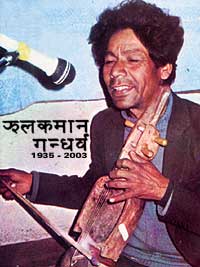
Late Jhalak Man Gandarbha is one of the most significant Nepali folk singers. He is popular for Gandarbha Sangeet, a popular type of folk song sung only by the Gandarbha ethnic group of Nepal. He is the first singer to record a song and is respected for bringing the voice of indigenous and ordinary people into the mass media. Aamale Sodhlin Ni … (Mother may ask …) is by far his most popular song, which intones the death of a Nepali soldier on a foreign battleground. To honor the greatest Nepalese singer the government of Nepal has built few statues for Gandarbha.
Khim Bahadur Gandarbha
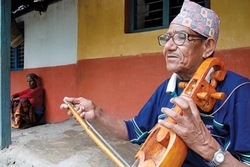
Khim Bahadur Gandarbha is an old, well-traveled talented musician as well as a revered teacher living in the place called Batulechaur. He started teaching more than a decade ago with the hope to pass on the knowledge and tradition gathered from a lifetime of accomplishment. He has taught more than 250 students about the traditional way to play Sarangi and his students are from Batulechaur to as far as Mexico and Finland, America and Switzerland.
He has been honored with many awards and recognition and his tiny home is adorned with pictures and medals describing the story of his success and achievements. He had also received a medal from Chairman Mao, the late leader of China and from King Mahendra along with a lifetime recognition award by Pokhara’s Rotary Club for his dedication to teaching at Pokhara’s Institute for the arts, the Sangee.
Hom Bahadur Gandharva
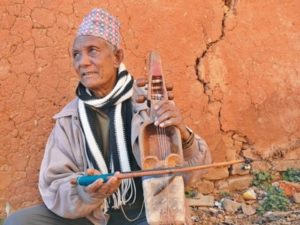
Popular sarangi player, Hom Bahadur Gandharva is from Palpa. Hom Bahadur is a popular singer cum musician who hails from the western hills of the country and is famous for his song “Honi Maya”.
Kiran Nepali Gandarbha
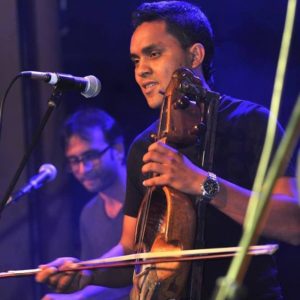
Kiran Nepali, a renowned Sarangi player from Nepal, is a member of the folk band Kutumba. He is a third generation Sarangi player in his family and explains that he is greatly influenced by his grandfather, father, and uncles, who were all Sarangi players of their times. Kiran spent 4 weeks studying the Sarangi in the Batulechaur area, a well-known Gandharva settlement close to Pokhara. Kiran also plays the guitar and teaches Sarangi at the Mitrata Music Program, created by the PFC Foundation in an orphanage located in Kathmandu. He is running a project called “Project Sarangi” to promote the folk music of Nepal.
He says, “The sarangi is not a very loud instrument. Musicians try to work with microphones on stage, but there is a lot of feedback to deal with”
In this journey Kiran, the sarangi player has in many ways, been a catalyst for the evolution of the ethnic instrument. And it’s definitely more than just wanting to play a unique instrument. It’s about developing what you love.
Music has always been an important part of our culture. Ram Prasad Kadel and the Music Museum of Nepal have been working as fast as they can for many years to record as many of the old masters as they can for their archives. As Ram explains it, preserving some of the great old traditions, so he is working as hard as he can to save these jewels for future generations. But with little money and resources, his museum is still quite humble and small, though beautiful and very well presented.
More to this, the Mountain Music Project made a documentary film a few years ago on how similar Appalachian old-time music is to the Gandarbha music here in the Nepali Himalaya, they have discovered that this other cousin of traditional music has been kept alive in the US as well. Our pieces of music sound similar; scales, and themes are similar. On the Mountain Music Project CD, some of the great musicians like Tim O’Brien, Tony Triscka, Riley Baugus, Curtis Burch, and many other extremely knowledgeable pickers were blown away by how similar out music really sounds.
Lastly, the musical messengers, the community of occupational caste musicians Gandharva, fulfilled the exclusive role of relaying information from one place to another with a soft musical tone played with the traditional Nepali musical instrument Sarangi. Their music needs to reach people who will value an art form that is different than what’s mainstream because there is so much artistry, so much poetry, and so much soul in their art.
Related Products:
[product_embedder_blogs product_id=”1924″]
[product_embedder_blogs product_id=”771″]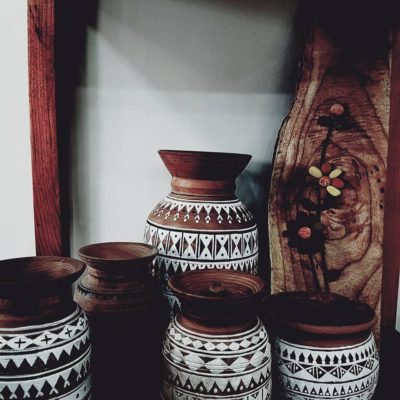
Theki and Madani – the traditional butter making process in Nepal
With thousand-year-old cultures and diverse ancient regimes, Nepali lifestyles have always been fascinating. Time is changing so in Nepal, in recent times Nepali lifestyle had seen a gigantic shift with the intervention of modern routines in upbringing.
These days’ traditional equipment and devices we used on daily basis are being replaced by modern technology. In Kathmandu valley, local technologies persist in making statue and pottery. Whereas in the Hilly region, carpet, plague, water grind mill are the prevailing technology. The shift is overwhelming as well as saddening at the same time. Why? Well! Because this change has caused the old Nepali values to lose luster and at the same time has allowed coming face to face with the boons of having a contemporary way of life.
This is one good thing, however, we really miss that wonderful traditional stuff which was part and parcel of our childhood. These are directly connected to the lifestyle of every Nepali. Being an agricultural country many technologies are in practice for many years in Nepal.
Butter making process is an art and science. It’s not magic, but the experience of churning cream to obtain soft, smooth, fresh, butter is magical! Born in Nepal, it is instilled in us that milk, cream, butter, yogurt, buttermilk are the part of our life, and good for health.
Here we present the local tradition of making butter in Nepal with THEKI AND MADANI.
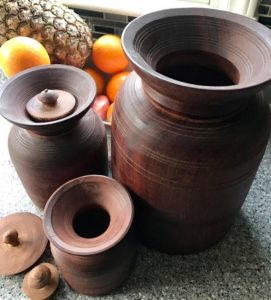
Using the Theki to Churn Buttermilk
Theki is the biggest of all devices used in churning butter and is the basic foundational device used. Cylindrical in shape at the body, it has a narrow neck while the mouth is a spreading fan-like structure. It is most commonly made up of darigitho wood. It is usually used to store milk fat and make butter out of it which can later be cooked to make the clarified butter also known as ghee and also make buttered milk. The “Theki” is only a vessel, whereas the “Madani” is like a thick stick with turbines at one end.
To make all these products we first need to keep the “Theki and Madani” near a pillar so that Madani can be tied very loosely (in fact right parallel to the pillar). The “Madani” is then wrapped around spirally by another rope in such a manner that when you pull one side the other gets smaller (if that makes sense just like a hand exercise). The curd accumulated over a period of few days is brought and collected in the Theki.

The “Madani” is then kept inside the “Theki” with milk fat in it. Slowly the person starts to rotate the “Madani” until the butter separates from the curd. As there are turbines present it works like a mixer grinder and separates the fat and the buttered milk. The addition of hot water in the middle of the process can fasten the process.
This chum-staff moves in alternate rotational movements caused by the pulling of a leather strap which is wound around the axle of the beater. The fat floats on the top which are collected both ready to eat or make clarified butter and the buttered milk remains at the bottom are usually sour but thoroughly enjoyed by everyone.
In Short,
1. Use Theki- a wooden tub and a Madani – a stirrer.
2. Separate butter oil from raw milk to preserve milk fat.Butter is not rinsed, but it is immediately heated to make butter oil. Butter melts immediately and will start to bubble when it is heated. A clear, liquid butter oil is formed when the bubbling stops. It is said that butter oil can keep for several years at room temperature. It has become a valuable seasoning used to flavor dishes. As in whole, butter churning is an important part of Nepalese livelihood. Not only a part of a day to day activity, but it is also a component of the traditional culture and identity of Nepalese society.
Theki in Nepal is considered sacred, it is not washed with other utensils and people generally do not touch a Theki while they are eating or with the same hand with which you have had non- vegetarian food. The reason for that is once the butter is extracted, it is offered to God over a burning heap of coal, which releases a nice buttery aroma purifying the whole house.
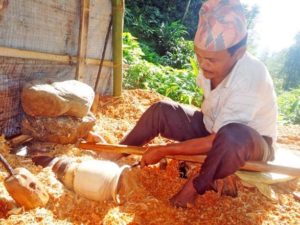
This characteristic of the milk processing technique transcending the framework of ethnic groups and shared in a region. Some people might never know how much calories are burned to Make Ghee/Butter by this process. Later, this cream is collected and eaten by mixing with rice or Htsampa (Htsampa refers to roasted barley flour).
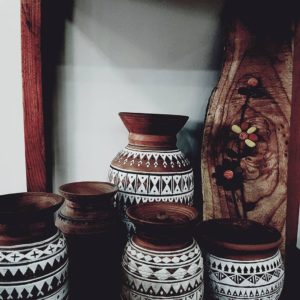
Theki and Madani now are turning out to be an antique household item; very few houses in the villages have it. We don’t think people living in the cities own it anymore. If you are planning to acquire one then we strongly recommend you do so. If you don’t intend to use it at all or would want to use it occasionally, it will make for a good antique showpiece in your living room or any other part of your house.
[product_embedder_blogs product_id=”9820″]
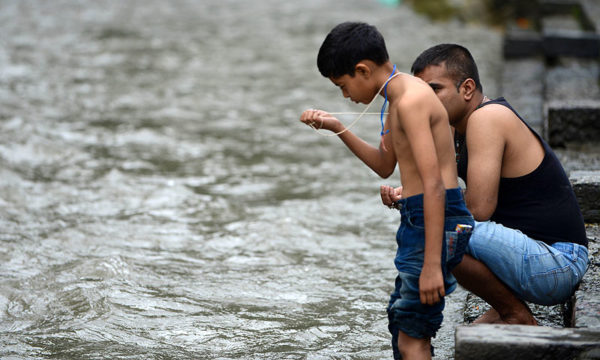
Festivals Celebrated In Nepal
Festivals celebrated in Nepal
Being a multicultural country, there are so many festivals in Nepal. Albeit native, I find it difficult to keep track of so many Nepali festivals as they seem occur almost every month. Nepal is often considered to be the mystic Hindu kingdom which is not entirely true, as the country accepted the system of federal republic and secularism after the second popular movement of 2006. if you happen to glance the recent census of Nepal, you’ll observe multitude of races residing in different parts of the country and been following their own set of culture. Festivals appear as joyous part of the culture during which the people celebrate with the family, community and relatives. Originally, festivals were celebrated to mark any auspicious occasions like good harvest, plenty of rainfall, abundance of domesticated cattle in the agrarian society. So, the practice of agriculture in Nepal can be taken as one of the major reasons for the endless festivities.
Festivals in Nepal differ depending upon the people celebrating it; it might be whole country, a certain race, people belonging to certain geography, a certain religion, certain gender et cetera. I am going to divide the festivals under the headings I mentioned so that you’ll get to know the major ones in detail.
Festivals celebrated by whole country:
Though Nepal is a secular country, more than 80 percent of people follow Hinduism, making Hinduism as DE-facto religion. So, two major festivals Dashain and Tihar (Deepawali) which are celebrated to mark virtuous and important events in Hindu myth is celebrated all over the country, albeit in different way depending upon the geography and races.
Dashain
Dashain is undoubtedly the major festival in Nepal which is celebrated all over the country i.e. by almost all castes, creed. It is celebrated by Hindus to mark the victory of Rama (mythical demigod also known as one of the many incarnation of Lord Vishnu) over Ravana (cruel King of Lanka, present day Sri Lanka) and also victory of Durga (fiercest Hindu goddess) over the demon. Suffice to say, Dashain is celebrated to signify the victory of good over evil.
Popularly known as Vijayadashami, a 10 days celebration which signifies the days taken by Durga to kill the demon and Rama, the Ravana, every days are celebrated in their unique way. Devotees visit different Durga temple to offer her with the gifts and extravaganzas while some others prefer fasting. Following are the important days of Dashain
The first day of Vijayadashami is called Ghatasthapana,well, it’s a ritual when the eldest of the home prepares Jamara (saplings of wheat and oat on the sand) which will be offered on the tenth day, also known as Dashami, to the sons, daughter in laws, nephews, and all other relatives.
Seventh day of Dashain is called Fulpati. Fulpati, literally refers to flowers and leaves but actually there are nine different ingredients in it such as Banana plant, turmeric, Flower, Pomegranate, Rice stalk and so forth. In nepal, during this day, there’s a century long tradition of bring Fulpati from the House of Gorkha (origination of Shah dynasty) to Hanuman Dhoka Durbar.
Eighth Day is popularly known as Maha Ashtami when goats and buffaloes are sacrificed for goddess Durga. There’s popular held belief that this ritual makes the goddess happy.
Tenth day, also known as Vijayadashami is the most auspicious day. During this day, elder of the family offers the jamara, which grows to decent size along with tika (rice grains mixed with crimson powder) is offered to his/her descendents and the relatives. Elders also grant the blessings along with tika, so that relatives utilize five more days after vijayadashami going to different relatives.
Tihar (The festival of lights)
It is regarded as second popular festival in Nepal which is celebrated by almost everyone as it is also known as “festival of colors”. As it occurs just fifteen days after dashain, September- October can be taken as festive season in Nepal. Legend has it that, Dipawali, which literally translates to lighting the lamp, is celebrated to welcome Rama and Laxman, home (Two Hindu demigods) as they return after defeating Ravana (Evil king Of lanka). Also, this festival is popular in a sense that it strengthens the bond between Sisters and brothers. Tihar is also known as Yama Panchak (Five days of Yamraj, god of death) as there are five days of celebrations, namely:
Kaag Tihar (Crow tihar)
This is the first day of Tihar during which crows are revered and given sweets and different food items. According to hindu scriptures, crows are considered to be the messenger of Yama, the death god.
Kukur tihar (Dog Tihar)
The second of the tihar is celebrated by offering garlands, tika and different sweets and food to dogs. Considered as the gatekeeper of god Yama, Hindu devotee take this day for the veneration of the dogs.
Laxmi puja
In hindu myth, Laxmi is regarded as the goddess of wealth and prosperity. So, on the third day of tihar, laxmi puja is celebrated and on the same day people crack fireworks and
Perform deepawali ( lighting of lamps) all over their houses and abodes. During same day, Cow, which is taken as incarnation of Laxmi is also worshipped and given sweet dishes.Govardhan puja
It marks the fourth day of the Yama Panchak on which farmers venerate the oxen. Legend has it that this day is also celebrated to mark the one of the superhero of hindu myth, Hanuman.
Bhai tika
This is undoubtedly the auspicious occasion of tihar when the sisters put tika on the forehead of the brothers and share the gifts. This day stands as one of the important events to strengthen the bond between sisters and brothers.
Janai purnima
Also known as Raksha Bandhan in India and Nepal, Janai purnima falls on the month of August and is widely celebrated by people albeit in different way. In nepal, this festival holds the major religious significance in relation to lord shiva as Hindu malle and make trip to famous high altitude lakes of nepal like Gosainkunda, Panch Pokhari and Jata pokhari. In addition devotee visit different rivers and shiva temples like pashupatinath in kathmandu,
During this festival, adult hindu males in possession of Janai (a six strands cotton given by priest to hindu adult which marks the adulthood) removes it and put a new one from the hand of priest. Also, the priest ties colorful cotton strands around the wrist which is believed to have certain power to protect people, hence named Raksha bandhan. Nowadays, on the same day, the brothers and sisters celebrate this day as Rakhi purnima where they exchange Rakhi (a colorful fabric which is put on a wrist) to strengthen the bond. A famous dish called “ Kwaati” (legumes and pulses) is served during this occasion.
Maghe Sankranti
Celebrated on 14th January, this festival marks the end of the winter solstice which lies in the month of Poush. So, basically this festival is the transition from treacherous winter often dubbed as inauspicious occasion to relatively warm and auspicious days. Devotees visit different holy places like Sankhamul in Kathmandu and Narayanghat in Chitwan. The major attraction of this festival is ghiu chaku (concentrated sugarcane mixed with ghee, nuts etc.), sweet potato, yam and other items of delicacy.
Holi (Festivals of colors)
Also known as festival of colors, this festival is celebrated to marks the day of love and respect among the people and neighbourhood. It is celebrated in the month of March all over Nepal and during this day people share different colors in each others cheek and shows the notion of universal love. In modern days, lots of foreigners are seen talking part in holi festival.
Don’t miss the chance to celebrate holi if you happen to visit Nepal during spring because it’d be the experience of lifetime.
Shivaratri
Believed to be the birthday of Lord Shiva, this auspicious day is celebrated in February all over nepal and india with much reverence. Devotee from all over indian-subcontinent visit the Pashupatinath temple, which include the sanyasis, deadlocked pot smoking hindu saints from northern India and Nepal where devotee chant the religious hymn (Bhajan) all night long. This festival is popular among the teenagers to almost all as smoking marijuana (ganja) is almost found commonplace during the day without any hassle of police force . Visiting nepal? Be sure you’ll do that during the time of Shivaratri to experience transcendental experience.
Buddha Purnima
Buddha purnima is celebrated on either May or June to commemorate the birthday of Siddharth Gautam Buddha, founder of Buddhism who was born in Lumbini, Nepal. Different programs are carried out all over the country and also a special ceremony is carried in Boudhanath, Swoyambhu, and Lumbini.
Festivals Celebrated by Ethnic groups
Losar
Losar is regarded as the new year by various ethnic groups of Nepal who follow buddhism like Tamang, Gurung and Sherpa. But the day varies according to the ethnic groups. Sherpa celebrate Hyolmo losar, Gurung celebrate Tamu losar and The tamangs celebrate Sonam Losar. Mostly losar falls on the months of February and March. Besides Nepal, losar is celebrated by Tibetans and Bhutanese as the new year. During this day, especially in cities like Kathmandu and Pokhara, you can see the young damsels in their traditional attire walking on the street and gathering on Tundikhel of Kathmandu where major celebrations occur.
Udhauli and Ubhauli
These are the annual festivals celebrated by the indigenous group residing in eastern hills of Nepal. Known as Kirat. In literal sense, Udhauli means to move downwards whereas ubhauli means to move upward. So, legend has it that Kirati (basically Rai and Limbu) celebrate udhauli to mark the downward migration of birds from the colder region which hints the arrival of winter and you have probably guessed about Ubhauli as the festival to mark the upward migration of birds signifying the arrival of spring and yes you are right.
Basically udhauli falls in October whereas Ubhauli occurs in March; during both occasion the male and female of Kirat perform the dance called “ Sakela” which in previous times would be taken as occasion to confess one’s love for other and hence a perfect romantic courting ceremony.
Just like in Losar, during ubhauli and udhauli, young maids of Rai and Limbu decorate themselves in their traditional attire.Maghi Parva
Maghi is celebrated as New year by the ethnic group of western and eastern tarari , Tharu. Especially if you happen to travel western plain land of Nepal like kailali and kanchanpur during mid – january, this festival can be observed. Tharu people perform their traditional dance, also known as “ Sakiya nach” during this week log festival when in addition to dance, they clean their home and prepare the favourite dish and offer it to the relatives.
Gai Jatra
Gai jatra is celebrated by the Newar community (natives of Kathmandu valley), annually to mark the death of loved ones on the same year. This is also a week or so long ritual which is celebrated in the month of Bhadra (August- September). During this festival, cows are marched on the street or the young ones, decorated as cow walk on the street along with the family members and they are offered with gifts and food by the community members. This would be the great opportunity for you to explore Kathmandu valley and its cultures, as different lavish way of celebration reveals the long preserved tradition of Newars.
Festivals Celebrated in different geographical regions
Gaura Parva
Mostly, this festival is celebrated by the people residing in midwestern and far western hills of Nepal. The word gaura comes from Gauri, wife of Lord Shiva, so the devotees on this day performs the typical dance of Midwestern and far western known as deuda naach, to celebrate the union of Lord Shiva and Gauri. The speciality of this festival is its demonstration of reverence of women, a central dogma of Hindu philosophy. So, devotee perform fast on this day and visit the Shiva and parvati temple. In kathmandu, Deuda dance is performed in city ground, Tundikhel.
Chhath
Legend has it that Chhath started as a major festival of Mithila region which lies in central terai of Nepal and Bihar Of India. Nowadays, almost all people of terai region celebrate this festival on October during which they worship Sun god and his wife Usha for all the bounties they have bestowed upon the humankind. Celebrated for almost four days, devotee perform fasting and offer tarpan (offering) to rising and setting sun visiting different water sources like rivers and ponds. Along with this, people prepare sweet dish and serve it among relatives and loved ones.
Festival Celebrated By Women
Teej
Teej is the greatest festival of hindu women of Nepal which is celebrated in the month of August on which Lord Shiva is worshipped. According to Hindu Scripture, sati devi, worshipped and prayed to get Lord Shiva as a husband and as a result of her prayer she finally got him.So, today too, young hindu girls perform fasting on this day praying lord shiva for awesome life partner just like him and married women fast for the longevity of their husband. The women can be seen on red saree and jewellery during this month which signifies their adherence to this tradition.
Festivals celebrated in kathmandu Valley
In addition to above mentioned festivals, there are so many local festivals which are celebrated in Kathmandu valley. I will just talk about couple of them.
Indra Jatra
It is the largest of all street festivals in kathmandu valley which is celebrated to worship lord Indra, king of heaven. Believed to have started from 10th century by Malla king of to mark the establishment of Kathmandu, during this week long procession, masked dance of different deities is performed to make Lord Indra happy. Also, the chariot of Kumari, living goddess is also pulled during this festival. Well, if you are visiting kathmandu, you’ll not miss the festival as it centers around the Kathmandu Durbar square.
Bisket Jatra
Celebrated on Nepali new year, i.e mid april, this is one of the major festivals of Bhaktapur region. A huge chariot of god bhairav is pulled by the local people around the places, which is prepared a month earlier in nyatapola temple of Bhaktapur Durbar Square. Celebrated with local wines and newari cuisine, this jatra ranks as one of the lavish celebration in Kathmandu valley.
There are so many festivals celebrated in Nepal besides from the ones i discussed above. Every lifestyle of Nepali is often reflected in the festivals they follow. Want to discover Nepal? Your quest of deciphering the hidden beauty of Nepal won’t complete if you don’t look at cultural aspects of Nepal.
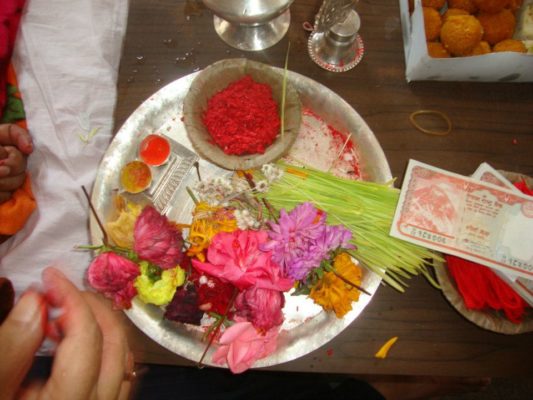
Dashain Festival in Nepal | Vijaya Dashami
Dashain- Festival celebrated in Nepal by whole country:
Dashain is undoubtedly the major festival in Nepal which is celebrated all over the country i.e. by almost all castes, creed. It is celebrated by Hindus to mark the victory of Rama ( mythical demigod also known as one of the many incarnation of Lord Vishnu) over Ravana ( cruel King of Lanka, present day Sri Lanka) and also victory of Durga ( fiercest Hindu goddess) over the demon. Suffice to say, Dashain is celebrated to signify the victory of good over evil.
Popularly known as Vijaya Dashami, a 10 days celebration which signifies the days taken by Durga to kill the demon and Rama, the Ravana, every days are celebrated in their unique way. Devotees visit different Durga temple to offer her with the gifts and extravaganzas while some others prefer fasting. Following are the important days of Dashain.
Ghatasthapana
The first day of Vijay Dashami is called Ghatasthapana,well, it’s a ritual when the eldest of the home prepares Jamara ( saplings of wheat and oat on the sand) which will be offered on the tenth day, also known as Dashami, to the sons, daughter in laws, nephews, and all other relatives.
Fulpati
Seventh day of Dashain is called Fulpati. Fulpati, literally refers to flowers and leaves but actually there are nine different ingredients in it such as Banana plant, turmeric, Flower, Pomegranate, Rice stalk and so forth. In nepal, during this day, there’s a century long tradition of bring Fulpati from the House of Gorkha ( origination of Shah dynasty) to Hanuman Dhoka Durbar.
Maha Asthami
Eighth Day is popularly known as Maha Ashtami when goats and buffaloes are sacrificed for goddess Durga. There’s popular held belief that this ritual makes the goddess happy.
Vijaya Dashami
Tenth day, also known as Vijayadashami is the most auspicious day. During this day, elder of the family offers the jamara, which grows to decent size along with tika ( rice grains mixed with crimson powder) is offered to his/her descendents and the relatives. Elders also grant the blessings along with tika, so that relatives utilize five more days after vijayadashami going to different relatives.
(cover photo courtesy of Tejaswee.shrestha)
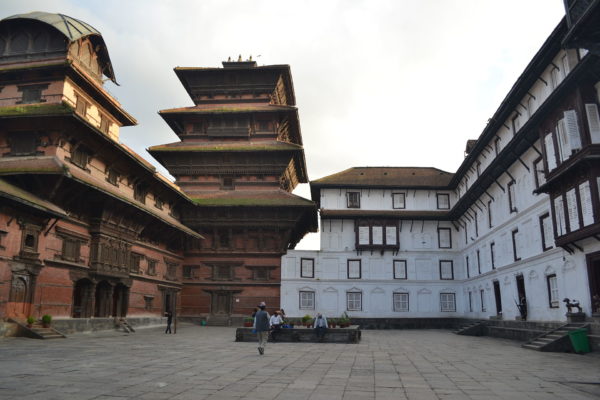
Nepal Tourist Places | Beautiful Places to Visit In Nepal
Nepal Tourist Places | Beautiful Places to Visit In Nepal
What’s the first thought that pops up in your mind on hearing the word Nepal? When I put this question to any foreigner I meet while trekking or traveling, I get the same answer almost every time and you’ve probably guessed it right. Its freaking Mount Everest, right? And guess what, I can’t help grinning when that answer slowly strikes my eardrum and my auditory nerve, languishing delivers to it the cerebrum because it’s amazing.
But wait, what about the few people who don’t answer same? If you have met any guy from Hippie generation or watched a movie “In the name of father starring Daniel Day-Lewis, you’ll know about freak street during 60’s and 70’s and the free drug spree. Well, those days are over now. Most of the foreigners, nowadays, when thinking about Nepal, think of talk about amazing Annapurna circuit, Durbar Squares, Lumbini, the virgin culture untouched by modernity and so forth.
You won’t believe it but Nepal was a mysterious land in Himalaya until 1950, its own citizens required the passport to visit different places and virtually closed to any foreign person except for the handful of British diplomats. But after the advent of democracy in 1950, everything changed and now it holds vast potential for the tourism industry. In this article, I am going to take you to little tour where you’ll visit beautiful places in Nepal.
I bet you’ve heard Bob Seger’s hit Kathmandu where he sings about mountains and desire to visit it. Well, turns out there are so many beautiful places inside Kathmandu which will not disappoint you.
Beautiful places inside Kathmandu:
Kathmandu Durbar Square
Well, I think I already talked about the legendary freak street of Hippie era. Guess what, it lies in modern-day Basantapur aka Kathmandu Durbar Square, one of the three medieval palaces of Kathmandu valley which depict the classic example of woodart and stoneart. Kathmandu Durbar Square is located in the heart of the city adjacent to tourist hub, Thamel. The major attraction of the palace square is Hanuman Dhoka palace which used to be royal palace of Nepal for Malla dynasty and later Shah dynasty till the 19th century. Also, you may be piqued by the Kumari bahal, a quadrangle which contains a kumari home, a home to the living goddess in Newari tradition. The 2015 earthquake destroyed some of the heritages like Kasthamandap, Bhimsen tower, and so forth, you can still feel quaintness as you breathe the air sitting on the balcony of one of the cafes in there. I assure you, you’ll feel lifted just by visiting this amazing piazza.
Bhaktapur Durbar Square
Want to visit somewhere peaceful, open, and quaint? I gotta tell you, Bhaktapur Durbar Square certainly holds all three attributes and maybe more. Even I feel so mesmerized by the tranquility I feel whenever I visit this centuries-long, intact palace square. Red bricks paved roads, vintage cafes, most of them having medieval architecture, you’ll be amazed to see 55 windowed palace which used to be royal palace of Malla dynasty till 18th century. Also interesting one is Nyatapol ( five storied) temple which remains intact even after 2015 earthquake. Filled with temples of various gods and goddesses, you’ll find this palace courtyard more spacious. Don’t forget to taste local yogurt (juju dhau) once you are in Bhaktapur.
Patan Durbar Square
You’ll be amazed how all three durbar squares vary in respect to their architecture, design and the temples. My personal favorite among three is Patan Durbar Square, not just because it demarcates the vibrant lifestyle of people in Mangal Bazar downtown from rest of the Patan, also because of the cafes, tourists and the locals blended together as one which gives me an awesome feeling. You can visit the Durbar museum and observe all antiquity from the 6th century and also experience an amazing cafe, away from all the crowds. You don’t want to miss the Sundari Chowk once you are inside of it. And trust me, the alleys of Patan Durbar Square will provide pleasure to your eyes where you’ll observe thanka, woodcrafts, and metalcrafts.
Boudhanath
Wanna feel serene and calm staring at the lamas rolling the beads and listening to the slow-paced Buddhist hymn? The best place for you can be, one of my favorite places in town, Boudhanath. Situated in Bouddha, few kilometers northwest from Kathmandu, it’s one of the few largest Buddhist stupas in the world. Filled with Tibetan restaurants which provide exquisite dishes, this is an absolute hideout from the fast paced metropolis. Boudhanath has an interesting history as it acted as a transit point between Indian and Tibetan traders during the medieval period. So, Tibetan traders started to offer garlands and offer their goods to then small stupa which, acted as a safe haven for the Tibetan refugees afterward. Today, if you travel through the alleys, you’ll be transcended to typical Tibetan community, where seniors can be seen counting beads, and lamas and nuns strolling around.
Swayambhu
Popularly known in the western world as Monkey temple, Swayambhunath is popular Buddhist shrine located on the west of the Kathmandu, atop a hill. According to Buddhist scripture, it is believed the shrine was self-created when Kathmandu valley was still a lake, hence the name Swayam ( self), bhu( existence). Today, this place consists of a large Stupa, which holds a central position in the faith of Nepalese Buddhists also there are so many temples which are thought to be made during Licchavi period. If you ever visit Kathmandu, the best time for you to visit Swayambhu is either early morning or at dusk by a short hiking. Walking past hundred of vertical steps, you’ll burn plenty of calories before you glance at enormous Stupa and serene eyes of Swayambhu. The panoramic view of Kathmandu valley seen from here during dusk is just awesome. Though this place is popular among Buddhists around the world, it doesn’t hurt anyone to visit it for the peace of mind. Being here, you feel like you’ve been transcended to such a blissful place, you never want to go away from.
Garden Of Dreams
If I have to say one good thing about Rana regime in Nepal ( who ruled Nepal from mid 19th century to mid-twentieth century), it’s their adaptation of European neo classical architecture in almost every buildings and garden they created. One of the finest manifestation can be observed garden of Dream which is located as an oasis in thirst ridden Kathmandu valley in the heart of the city, Thamel. Lying inside the Kaiser Mahal, this neoclassical, Edwardian style garden provides you an amazing ambiance and a haven to study, bask in the sun and simply savor its beauty.Besides, it also houses a natural library where visitors can take advantage of natural beauty inter related to historical and architectural flavor.The most striking of all is the six pavillion which depicts six seasons prevalent in Nepal. Along with it, you can fountains, decorative garden furniture, and European-inspired features such as verandahs, pergolas, balustrades, urns, and birdhouses. Plus, you can always try the amazing coffee at kaiser cafe located on the premises.
If Kathmandu offers you the immense cultural extravaganza, rest of the Nepal offers you the thrill of adventure and the virgin land of cultural plethora. I have list down the following places which will make your stay in Nepal worthwhile.
Pokhara
This cosmopolitan tourist hub is situated in the west Nepal needs very few explanation to you, I guess. Having Phewa lake as its courtyard, Pokhara offers immense and versatile atmosphere to people who want to seek pleasure and the thrill of adventure at the same time. The popular place in town, Lakeside contains the five-star hotels, famous resorts, and also, the hotels that fit your budget.
You can enjoy your stay at Pokhara by leisurely boating on Phewa lake or hike to begnas lake. For those who seek adventure, the availability of paragliding and bungee jump surely won’t disappoint. One thing about Pokhara is that it never fails to amaze me every time I go there. The ambiance during New year when Pokhara Street festival is celebrated is just amazing. Best time to visit Pokhara is any time of year, cool, right? I still haven’t talked about the World Peace Stupa which sits atop a hill and the hiking trail. This hike almost feels surreal as you can gaze at the behemoth Phewa lake and Pokhara valley. And the thing you don’t want to miss is the sunrise from Sarangkot, which also hosts the paragliding. As Nepal is often chosen as the recreational retreat, different places in pokhara offer mediation packages which will surely come as a bonus for you.
Annapurna Circuit
Do you want to trek for a month away from your comfort zone and humdrum of life exploring the remote villages and various ethnic cultures Nepal provide? Trust me, once you hear how awesome the deal is, you’ll feel like leaving your couch right now and packing your rucksack. Opened as a trekking circuit in the early 1980s, trekking in Annapurna circuit will offer you the amazing chapter in your life, which you’ll cherish for the rest of your life as this circuit is referred as “mother of all circuit”. This circuit will cover the places like Pokhara ( which I already described), Poon Hill, Ghandruk to all the way to Thorong-La pass in Manang which is at the height of 5000 meters from the sea level. Mark Twain has said that “nothing so liberalizes a man and expands the kindly instincts that nature put in him as travel and contact with many kinds of people.” Exactly. Trekking in the foothills of Annapurna circuit will bring you in contact with the people of so exotic culture which you had fathomed. While on the route, you’ll get to view three mountain ranges, Annapurna, Dhaulagiri, and fishtail. Basically, this trek takes you around these mountain range, so imagine how awesome it’ll be. Besides the mountain ranges, you’ll bump into the tundresque terrain of Mustang district, notably the places like Kagbeni and the famous temple, Muktinath. And descending down from Thorong la pass, you’ll land on Manang district, which lies behind the mountain ranges. The diverse culture of Gurung, Thakali, and other tribes are the major attraction of this route, not to forget the amazing view of the mountains.
Everest Base Camp (EBC)
Why do people go for mountaineering? I often used to ponder on this question until I read the books like “on the road” and “ dharma bums” by Jack Kerouac. He tells that traveling and mountaineering is one of the ways for spirituality. Like him, I too believe now that traveling is all about deciphering myself. So, which is the farthest place on earth can I travel to unravel my inner self? Without a doubt, it’ll be the scaling of Mount Everest. Wait now! I am not telling everyone should do that but what I am trying to put is every travel enthusiast should at least go for EBC trek. For the adventure tourism, this trek is just number one. You can trek EBC either during March-May or September-December. Your journey will start by landing on the most dangerous airport in the world, the Lukla airport. Acclimatizing yourself at Namche Bazaar located at the height of 3440m, you can prepare for your journey which will offer you unparalleled natural beauty. On the way up, you’ll arrive at the famous monastery of Tengboche at a height of about 3800m which will certainly imbue the sense of belonging to the mountain god. It is often said, traveling on a mountain is the only time when the human realizes the insignificance of his ego and all the wildest hopes and desires. EBC is located at the height of 5346m, so any normal person can easily perform this trek without any problem. So, what’s special about it? Well, like I said, the sense of personal growth, immense hospitable people of Solukhumbu and majestic mountains will surely win your heart.
Sauraha, Chitwan
When did you last go on a jungle safari riding on the Elephant? Never? Don’t worry, just pack your bags, update your passport and head to Nepal because there’s nowhere better jungle safari in affordable price than in Sauraha, Nepal. Located inside Chitwan national park, home for one-horned rhino, Bengal tigers, deer and countless birds, you’ll encounter with a quiet Tharu villages ( native of Plain of Nepal) while your stay there. Chitwan is located 160 kilometers south of Kathmandu,155 km by road from Pokhara and 160 km by road from the Indian border at Sunauli. While you are at Sauraha, you can do many things which I’ll just list them below:
watch the sun set over the National Park which is just jaw dropping and you’ll wish it never ended.- Go for a ride on an elephant as long as you prefer
- Watch different birds on the oddly-named Bis Hajar taal
- Stay overnight in the jungle spotting wild animals from the lookout tower
- Watch Tharu cultural show which you’ll be intrigued and piqued by.
- Hire a bike and wander about Tharu villages
- Swim in the Rapti river and get bathed in an elephant
- Drink cool beers at one of the “beach” bars
- Go for a jungle safari on foot, by elephant or by jeep
- Go for a canoe trip on the river.
There are so many Western-style hotels and cottages in Suraha, so you shouldn’t be worried at all regarding the accommodation. Also, the presence of local eateries are also the plus points if you want to go for local cuisine. Above all, Sauraha will be the best hideout for luxury tourism, if you are seeking for one. And wait, the best season to travel sauraha is from November to April.
Lumbini
There’s often misguided truth regarding the birthplace of Siddhartha Gautama, popularly known as Buddha. Most of the western researchers have falsely claimed that he was born in India. The truth is he was born in Lumbini, 22 km west from Bhairahawa ( one of the popular trading city which is located 265 km south west of Kathmandu). Though it is primarily a religious site for millions of Buddhists around the world, agnostics and pacifists revere this place equally. Since Buddhism is practiced as a philosophy rather than a religion in most of the western societies, the visit to this place creates a kind of emotional stir. Just think about how a person born in this very place around 563 BC has changed the way we perceive human life and other creature, it’s amazing, right? You can actually see the exact birthplace of Buddha upon which Mayadevi temple is built in the honor of his mother. Lost in rubble for many centuries, the renovation and upgrading of Lumbini started since the late 19th century. Besides Maya Devi temple, today, you can observe the temples like
- Royal Thai Buddhist Monastery,
- Zhong Hua Chinese Buddhist Monastery,
- Cambodian Monastery, and
- World Peace Pagoda
So, if you ever visit Nepal, missing Lumbini would be a grave loss with capital G since this place, often overlooked holds a significant meaning for every human being. There are various ways you can take to visit Lumbini as various tour agency offer the combo package which will include the trip to different places including Lumbini. If you want to travel solo, you can board a plane to Bhairahawa from Kathmandu which is just easy as a pea.
Annapurna and Mardi base camp
Ask any foreigner about ABC and she’ll describe it in the more lucid way than any Nepali can. This is because almost all international tourist visiting Nepal go for this trek. Ascending upward from the queen of Nepal, “Pokhara”, ABC trek is famous for its quaint Gurung villages like Ghandruk which is located at 1940 m above the sea level, amazing places like poon hill and Ghorepani. ABC located at the height of 4130 m above sea level is the best trekking option for anyone visiting Nepal as the trek can be completed in about 10 days. This trek is popular among solo traveler to trekkers in a group too as hundreds of people from almost all around the world seem to scale this track every day during trekking seasons which are Autumn and spring. Starting from the foothill of revered Fishtail mountain, one can kiss the foot of Mt. Annapurna, one of the tallest peaks in the world. The most humanistic aspect of this trek is not just about the natural beauty but acquaintances with so many people, which give you a strong faith in humanity.
Mardi trek just starts on the east of ABC trek; matter of fact, it’s probably less trekked track which holds a significant potential. Ascending up from Pokhara, the trail leads you to the lush rhododendron forest ( if you travel during spring) which runs to the height of 3300m from where the path changes to rugged mountain scope. You can, from this height watch the magnificent mountains like Machhapuchhre (fishtail), Mardi Himal, Annapurna South and Hiunchuli. If you want to go to Mardi Base camp from High camp ( 3850m), it just takes 3-4 hours. Once you are in the Base camp, you can observe the undisrupted view of whole Annapurna range. Availability of cheap hotels and homestay means you can have a medium sized trekking packages with plenty of fun. And, like always, the cultural extravaganza and immense hospitality of people is always like the cherry on the top.
I hope my description of beautiful places in Nepal can be of a great help to you if you are seriously considering to travel Nepal. After the mega earthquake of 2015, most of the heritages are in the process of renovation. So, your travel can actually boost up the process. After the end of the civil war which lasted for almost 11 years and the political transition, Nepal is looking to offer its natural and cultural heritages to be observed by the people in the world so that collectively, we’ll be the better human.
WoodCrafts | History of Wooden Crafts in Nepal
Whenever I see the manifestation of all the Hindu Gods and Goddesses, Buddha and deities in the wood crafts, I make up my own assumptions of their creation. I believe that an artist wanted to express his imagination of the divine being into something tangible so that his fellow species could revere the faith instilled in that being. It may sound rather poetic.
But if we trace down the history of the wooden crafts, the oldest evidence goes back to Bavarians and Scandinavia who prepared hunting gears, coffin, and animals out of wood.
Also, the civilizations of Egyptians and Chinese practiced wooden craft too much extent which is depicted in the artistic tombs of pharaohs, and the wooden gates in Chinese palaces. If we talk about the wooden craft of Nepal, history dates back to the Licchavi period, when the famous Changunarayan temple was built with astonishing wooden artwork. Since then, with the rise and fall of different dynasties, Nepal has upheld its unique skill of craftsmanship.
Not much is known about how and when the wooden craft began in Nepal but one can correctly predict that it was the Licchavi period that started around the 4th century AD has played a distinctive and substantial role to shape the architecture of temples and buildings of Kathmandu valley and Nepal as a whole.
Also, the Malla period which started somewhere between the 12th and 13th centuries in Kathmandu helped to resurrect and modernize the Lichchavi architecture.
The prominent temple during the Licchavi period is the temple Changu Narayan which is located at Bhaktapur district and one can clearly get a glimpse of how woodcraft had played a major role in shaping the faith of then citizens to god.
One should always know that the idea of culture and the religious practice root from the ability to relate the god’s presence amid human souls and to portray gods in human form. So, the use of woods became prominent in making of any temples and the sacred building which would be bestowed by God’s presence. That’s why you can observe various gods and goddesses carved in the doors and windows of temples in Nepal.
If we take Changu Narayan to be the oldest temple of Nepal, the use of woods can be seen to carve the Hindu and Buddhist motifs and the demigods.
Later, during the Malla period, additional art is popularly known as “Tudal” started. Influenced by most of the Hindu temples in Northern India, the artisans of Nepal started to carve erotic art on the woods used in “Pagoda” style temples of Kathmandu.
Malla period further influenced the Newari population living in Kathmandu to embrace the then-popular architecture while building their homes. So, it can also be said that the culture of woodcraft slowly permeated and took hold in the Newari society. It was when Jayasthiti Malla, 14th century Malla king of unified Kathmandu valley created the caste system, a separate clan with the Newari society was given the job of woodcraft. Since then, the practice has been continued and transferred to generation.
So how have these astonishing woodcrafts come to life? My question was answered when I happen to visit different wooden workshops in Patan. Today there are few major wood crafts workshops in the country that haven’t let the quality of the goods taint over the years.
One of the artisans named Rajesh Barahi, who owns a small wood carving workshop in the vicinity of Patan Durbar Square explained to me the sequential process of creation of these crafts which include the selection of good wood, using the suitable tool to carve it, which highly depends upon the amount of description to be applied on the craft.
The color selection part is really tricky, he said since the texture of the craft holds a different aura. This delicate procedure made me ponder: why really do we need these items which are obviously not required for daily purpose? I hear the same questions from most of the people I’ve encountered so far. But if I may borrow the quote from George Orwell, “a society without beauty is soulless”. This explains the craving of humans, for these pieces of great beauty and aesthetic values.
Also, the true value of these crafts lies in their opposition to mass-production methods. Artists pay a lot of detail in the preparation of individual items which isn’t certainly an easy feat. Also, don’t you realize the shift in your mindset when you stand in awe watching the grandeur of art and craft of large halls in Patan Museum, the artistic rafters in the temples depicting obscure beauty?
Many psychologists have suggested the amazing healing property of interior designs of hospitals, and offices. Immense stress from the work and household can be relieved by just staring at a wooden frame clock or wooden statue of Buddha. The fact is, living in a beautified environment with a certain amount of individuality and beautiful objects add immeasurably to our enjoyment of life.
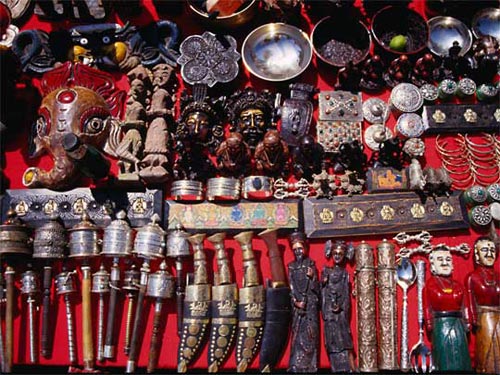
Handicrafts in Nepal | Nepalese Handicrafts
Strolling around the temples and the ancient palaces of Kathmandu valley, during dusk is one of my favorite habits. It’s not just that these places radiate a sense of serenity but the neighborhood filled with the antique shop full of Nepalese handicrafts and the temples with fabulous wood carving make my time worthwhile.
Handicrafts in Nepal are believed to have started since the Licchavi period (300-879 AD) though the official account of the first handicraft is not available. But the classical period of Nepal (13th to 18th century) ruled by the Malla dynasty helped, extensively in the enrichment of quality, authenticity, and originality of the Nepalese handicrafts.
In today’s hi-tech and industrialized society, the mere glance of handmade and eco-friendly products lifts our tired spirits. Especially, obtaining the authentic and local handicraft gives us pleasure, nowhere to be found. In Nepal, especially in Kathmandu valley, the tradition of craftsmanship is still preserved, thanks to the close-knit Newar (Indo-Burmic in origin believed to be natives of Kathmandu valley) communities who have been practicing it for many centuries. So, there is still the chance to feel the originality and the local-ness in the variety of handicrafts.
Basically, handmade crafts in Nepal can be divided into two main categories viz. textile handicrafts and non-textile handicrafts. The details of these categories are what I intend to describe in this article.
Textile products
It includes, along with pashmina, wool, Dhaka (one kind of local textile), hemp products, also (nettle fiber), felt, silk, and cotton goods. These materials are extensively used to prepare clothes, bags, jackets, shawls, trousers, and so forth.
Pashmina
In Nepal, the source of pashmina is the fur of the Himalayan goats (Chyangras). Since they are reared in the high altitude of Nepal, pashmina is an item of rarity. Often used to make the pashmina shawl, these days, with the advancement of technology, manufacturers in Kathmandu have been exporting Pashmina goods via the internet too. Though the pashmina industry experienced a downfall because of the wide use of fake furs, after the strict scrutinization, the business is booming again.
Dhaka Products
Widely considered to be the pride of Nepal, Dhaka is the local textile that has been widely used as Nepali Cap (Dhaka topi), blouse, and shirts (Kamij). During festivities of Newar and hilly people, women can be seen in colorful Dhaka attire that captures anyone’s eye. Believed to be originated from western hills, today, Dhaka represents the identity of Nepalese.
Woolen, hemp, felt, and cotton goods
If you travel on the alleys of Thamel or Patan, you can clearly observe the bags made up of hemp, or the scarfs made up of silk with art crafted by skilled artisans. Not to miss, woolen products such as jackets, pullovers, ponchos, mufflers, hats, gloves, and socks are textile handicrafts found in Nepal. And after 2006/7, the products of felt (somewhat like woolen are in optimum demand.)
Non-textile handicrafts
It consists of woodcraft, stone craft, metal craft, silver jewelry, leather goods, Thangka/Paubha (religion-based paintings), bone and horn products, handmade paper products, incense, ceramics items, bamboo products, and plastic items.
Woodcraft
Maybe one of the oldest and popular handicrafts in Nepal, Woodcraft has been practiced by Silpakar (woodcarvers), the distinguished clan of Newar. Various products made out of wood can be found in Nepal which includes miniature statues, and tools for daily use crafted by skilled artisans.
Metal crafts
Undoubtedly, metal crafts are the most popular and widely exported handicrafts of Nepal along with woolen and cotton products. Crafted by the members of Tamrakar (copper crafters and idol makers), metal crafts are often found in different varieties. The magnificent statue of Buddha, Ganesh, Shiva, and different deities are prepared out of copper and silver. One simply doesn’t get tired walking the alleys Patan, where antique shops are filled with the amazing display of metal crafts. Initially, designed out of wax, the shape of the craft I encased in the clay mold which is heated to harden. Once the job is done, the wax is melted and poured out through the case and instead replaced by the metal of choice, often bronze and silver. Letting the shape to set, the metal being is extracted by breaking the mold; the final piece obtained by polishing and giving a final touch by a skilled artisan.
Silver jewelry
Silver jewelry is one of the most exported handicrafts from Nepal. The skilled artisans who are the member of Shakya and Bajracharya (Silversmiths) have been exploiting their talent and crafting fabulous silverware.
Thangka/Paubha
Kathmandu is often quoted as the city of temples. The cultural and religious environment in Nepal is a mixture of Hinduism and Buddhism. Thangka is a religious-based painting, especially Buddhism and the amazing and mysterious lifestyle of Lamas. It depicts the lifecycle of the Buddhist deities and the historical incident.
Paper Crafts
These products can be considered as a recent addition to the Nepalese handicraft. After the introduction of the concept of recycling and reusing of the materials citing the environmental concern, various useful products are made out of paper and plastics.
There are so many online stores in Nepal, that are established with the sole purpose to promote the handicrafts of Nepal, and add to this, with the advancement of technology, each buyer can go through each product review on the internet before spending money on it.
There are some locally owned and charitable online stores that want to keep the tradition of Handicraft alive in the country by spending a certain amount of their revenue in social sectors of backward communities. One can, easily, from her apartment in Sydney or Chicago can get handicraft items on her door without much hassle and delivery charge in today’s highly sophisticated world.
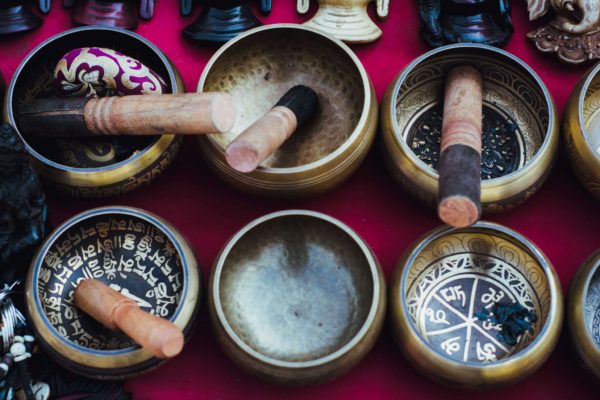
Nepali Singing Bowls – Also called Prayer and Healing Bowls
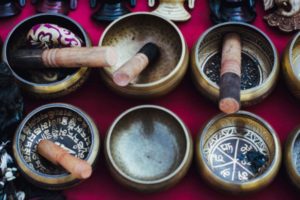
Nepali Singing bowls | Himalayan Bowls
Can you stand a minute listening to the cacophony of a crowd or a pianist playing just a single note? If you are unsure, why don’t you give a try? But, I bet you’ll be ready to pay hundreds of dollars to attend the popular orchestra or to buy Beethoven quartet or Mozart’s record. Why do music and sound affect us so much?
At the microscopic level, the physiological aspect of the human body performs a different feat that outsmarts layman’s intuition. According to neuroscientists, the human brain composed of trillions of neurons acts as a natural oscillator with distinct frequencies.
And when it encounters the external sound, the harmonics and the overtones comparable to frequencies of our brain waves form a mutual phase locking which brings about significant change in our emotions.
Though we are known to this reality in the 21st century, it seems that our forefathers; as Westerners see, the great mystics and Buddhists Lama of Himalaya knew this fact and even created a sound healing mechanism using singing bowls based on this fact.

Singing bowls, also known by the name Tibetan singing bowl are sometimes referred to as seven metals bowl are one of the oriental pieces of metalcraft, the application of which range from meditation, sound healing to the musical instrument.
Also read: Metal Crafts: How are they made
History And Origin Of Singing Bowls
Less is known about the actual origin of the singing bowl but ideas and facts gathered from the anecdotes, it can be assessed that its origin has roots during Buddhist civilization since Buddhism regards our existence as a vibration in this cosmic universe, the idea of sound remained so ingrained in their philosophy.
It is even assumed that Buddha himself brought the singing bowl from heaven and the rests are a copy of it. Legend has it that the use of these bowls date back to Bon religion in Himalaya, way before Buddhism was founded.
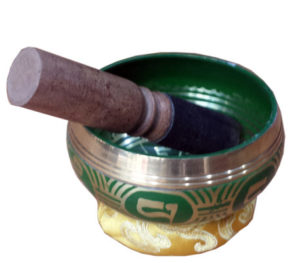
Composition of Singing Bowls
It is believed that they were traditionally made using seven precious metals like gold, silver, and such though, in modern times, these are mostly mass-produced from the alloy of copper and tin (bronze)but still, the handmade singing bowl can be found which are said to be made up of copper, tin, gold, silver as chief metals.
Since the composition of the singing bowl is bronze, it’s still debatable whether it was originated in Tibet or in Nepal? Without any written proof, it can be said, judging the skilled artisans of Nepal that its origin took place in this land of the Himalayas which later flourished in Tibet, northern India, and East Asian countries. This proposition can be further proved by the use of it in different ceremonies by Shamans, Lamas, and religious priests in ancient Himalaya.
Healing Mechanism of Singing Bowls
Today, the singing bowl isn’t just given religious importance but is popularly used in sound healing mechanisms, meditation, and even as a musical instrument. The quality handmade singing bowl is supposed to create a vibration that lasts longer and synchronization with brain waves decreases the heartbeat and other vitals providing a person a soothing feeling resulted from the healing of tissues and smooth functioning of the glands.
Even though allopathy and technological feat has changed the fate of global medicine practice, oriental methods of healing haven’t lost its charm. It is assumed that our body consists of seven chakras, which regulate the body, so whenever one of the chakras is blocked, a person gets ailment.
This is when the vibrational energy of the singing bowl resonates with the frequency of that chakra, safely regulating it. Though taken as pseudoscience by skeptics, recent research on the effects of sound on health has revealed many facts in support of sound healing.
Singing Bowls for Meditation
People, nowadays, use the singing bowl for meditation purposes because of the prolonged soothing vibration produced in it. The harmonics and overtones produced by rubbing the mallet around the edges of the bowl bring about resonance in the brain wave thus providing an ideal situation for meditation.
Where to Buy Singing Bowls in Nepal
If you happen to travel to Nepal, don’t forget to visit antique shops in Thamel where you’ll encounter the shops that trade singing bowls, Khukuri, and other handmade crafts and hopefully also the workshops. Since the western world came to a realization of sound healing after the ’90s, the sales of the singing bowl have increased in Nepal so that many of them are machine refined for faster production, which despite their alluring appearance does not always serve the required purpose.
So How To Choose The Best Singing Bowl?
It is said the best ones are the handmade ones which are created by repeated hammering and heating for about 4 to 5 hours. But there’s no easy way to identify the quality which is why it is advised to choose them based on their sound quality and its prolongation.
Singing bowls, since are found in different sizes, choose the one which you can easily hold in your hand and produces a soothing sound when the mallet is moved around its rims. Or else you can ask someone else to play it for you and judge the one of your preference.
How to Play Singing Bowls?
The best way to play it, according to most of the practitioners is to hold a singing bowl in a left hand, holding a mallet in the right hand. Then, the vibration can be produced by tapping the bowl and moving the mallet in a clockwise direction, applying equal pressure.
Useful and Advantages Of Singing Bowls
This way, ideal overtones are generated and are helpful for half an hour of meditation. Also, it is used to cure a headache by covering the head with the bowl and tapping it in a clockwise direction. There are so many cases of ailments where the singing bowls come up as the best healing tool.
It is said, traditionally singing bowls were created by authentic bronze, and meteorite iron along with silver and gold, the sole purpose of which is to create the overtones which are beneficial to the human brain and chakras. So one must pay close attention while playing it.
So, lost and forgotten are many of the Eastern secrets, which, when are discovered can revolutionize the prevailed pattern of livelihood just like singing bowl has done, albeit to less extent.
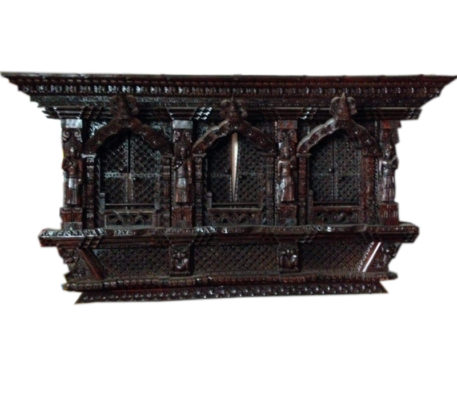
Woodcraft in Nepal – Religion, Art & Artisan
WoodCrafts in Nepal
One of the reason tourists visits Kathmandu is the breathtaking architecture of medieval palaces and temples in three traditional Durbar squares located in three different cities Kathmandu, Bhaktapur, and Lalitpur. These three culturally distinctive piazzas contain wooden and brick temples, so delicately designed and elegantly morphed together.
Legend has it that the name of the city, Kathmandu is derived from the Kasthamandap, the oldest known wooden temple built during Lichhavi, which was then formed by two words, Kastha means wood (a chief material from which a temple is made) and mandon ( temple or an edifice).
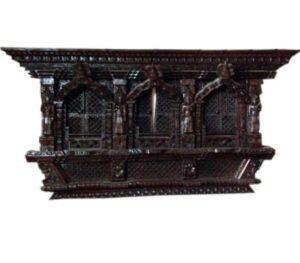 So, Kathmandu literally means “ city of wooden temples”. As you can see in most of the temples, using wood doesn’t hold much more important than the artistic touch it possesses. The intricate and artistic carvings in the pillars, brackets, struts, beam frames of the peristyles, window and door frames with the Hindu deities and religious motifs prove this statement.
So, Kathmandu literally means “ city of wooden temples”. As you can see in most of the temples, using wood doesn’t hold much more important than the artistic touch it possesses. The intricate and artistic carvings in the pillars, brackets, struts, beam frames of the peristyles, window and door frames with the Hindu deities and religious motifs prove this statement.But nowadays, woodcraft is not just limited to the beams of temples and palaces but the artisans carve the figure of Buddha, the elements of Buddhism, windows, doors, statues of different Hindu gods and goddesses, tables, artistic clocks, and the articles of day to day use.
The Nepali woodcraft tradition has three types of craftsmen: The Designers, The Woodcarvers, Traditionally from the Silpakar family, and the carpenters, commonly called Sikarmi.
But the tradition has slowly changed as different castes are coming ahead to perform this work.
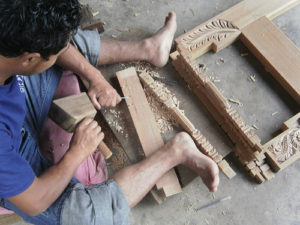 The designer and woodcarver are often the same people. The wood carving organization, so far, has been kept as a family business, the ideas being transferred to sons from the father. The work of woodcarvers is a broad specialization and belongs to the knowledge concerning iconography and religious significance of decoration.
The designer and woodcarver are often the same people. The wood carving organization, so far, has been kept as a family business, the ideas being transferred to sons from the father. The work of woodcarvers is a broad specialization and belongs to the knowledge concerning iconography and religious significance of decoration. One of the veteran designers Haribhakta Maharjan said that the complexity of an ornately carved deity, multi-handed and holding symbols all of religious significance, requires not only great knowledge of the religious texts but also the skills of a craftsman competent to execute the work.
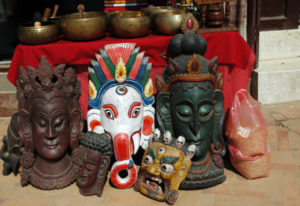 Most of the wood crafts are influenced by the Vedic and Buddhist ideologies. So, if you happen to see any sort of act depicted on the temple, be sure that the art holds some kind of meaning in the oriental religions.
Most of the wood crafts are influenced by the Vedic and Buddhist ideologies. So, if you happen to see any sort of act depicted on the temple, be sure that the art holds some kind of meaning in the oriental religions.Woodcarvers believe and worship the god called Vishwakarma, who according to a legend of Mahabharata, built a beautiful palace, the Mani Mai Sabhat, for their king who was so impressed by the window carvings as well as the beauty of the queen, that he was distracted enough to stumble over and fall into the water pool in the middle of the court. Vishwakarma is revered as Kuldeuta (deity guide/ personal god) by the traditional woodcarvers during the festive seasons.
Even though the majestic display of wooden craft in Kathmandu valley can be observed in the traditional doors and windows of Newars, the durbar square, and temples, nowadays skill can be found in different forms like small decorative items, handicraft gift like a picture frame, rack with hangers, wooden ties, small boxes, animals, buttons, furniture, decorative wall hanging, etc. from the limited items temples, wooden windows, and panels. Maybe the following descriptions of these crafts will be a great help for you:
Newari windows
As already explained above, Newari windows display the magnificent blend of Newari culture: the fusion of Hinduism and Buddhism. You can find different designs of Newari windows if you happen to travel three durbar squares of Kathmandu, look out for local workshops where skilled artisans can be observed busy with tools and woods. A few weeks ago, I met one of the American tourists, Richard, 80 years old in one of such workshops where he shared with me his fascination with observing those beautiful and delicately carved windows.
Wooden statues
Blessed with the rich tradition and cultural plethora, the temples of Nepal contains different gods and goddess each having their own significance. Nowadays, small-scale woodcraft industries create different forms of deities in different shapes and sizes with varying price ranges. You can get a piece of Buddha Statue for Rs. 1000 or else you can get the statue of Ganesh that costs more than Rs. 10,000.
Tables and beds
Who wouldn’t love to use the intricately designed wooden table in their office and home which radiates a sense of calmness and serenity? Carved in the durable wood of tropical trees like sal, these tables are durable and artistic with different religious motifs. Also, wooden sleeping beds are available in the major woodcraft industry which is carved with auspicious motifs like Astamangala.
Wooden framed clock
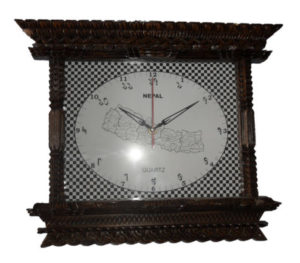 This can be yet another elegant classic item that can add beauty to your abode: watching the passing time on a clock embedded in the wooden frame prepared by some artisans in another corner of the world that radiate the medieval vibes of the oriental region.
This can be yet another elegant classic item that can add beauty to your abode: watching the passing time on a clock embedded in the wooden frame prepared by some artisans in another corner of the world that radiate the medieval vibes of the oriental region.In addition to the above-described items, you can observe different pieces of crafts in the courtyard of Bhaktapur, Kathmandu, and Patan Durbar square where many tourists and the vendors bargain for the price of the items. To those, who are a bit skeptical of their authenticity, there are so many local workshops where one can obtain the item, learning to carve, if desired.